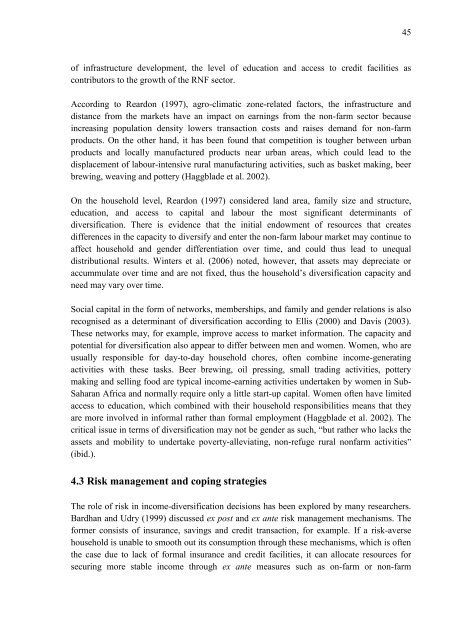Rural Income Generation and Diversification - A Case Study ... - Doria
Rural Income Generation and Diversification - A Case Study ... - Doria
Rural Income Generation and Diversification - A Case Study ... - Doria
You also want an ePaper? Increase the reach of your titles
YUMPU automatically turns print PDFs into web optimized ePapers that Google loves.
of infrastructure development, the level of education <strong>and</strong> access to credit facilities as<br />
contributors to the growth of the RNF sector.<br />
According to Reardon (1997), agro-climatic zone-related factors, the infrastructure <strong>and</strong><br />
distance from the markets have an impact on earnings from the non-farm sector because<br />
increasing population density lowers transaction costs <strong>and</strong> raises dem<strong>and</strong> for non-farm<br />
products. On the other h<strong>and</strong>, it has been found that competition is tougher between urban<br />
products <strong>and</strong> locally manufactured products near urban areas, which could lead to the<br />
displacement of labour-intensive rural manufacturing activities, such as basket making, beer<br />
brewing, weaving <strong>and</strong> pottery (Haggblade et al. 2002).<br />
On the household level, Reardon (1997) considered l<strong>and</strong> area, family size <strong>and</strong> structure,<br />
education, <strong>and</strong> access to capital <strong>and</strong> labour the most significant determinants of<br />
diversification. There is evidence that the initial endowment of resources that creates<br />
differences in the capacity to diversify <strong>and</strong> enter the non-farm labour market may continue to<br />
affect household <strong>and</strong> gender differentiation over time, <strong>and</strong> could thus lead to unequal<br />
distributional results. Winters et al. (2006) noted, however, that assets may depreciate or<br />
accummulate over time <strong>and</strong> are not fixed, thus the household’s diversification capacity <strong>and</strong><br />
need may vary over time.<br />
Social capital in the form of networks, memberships, <strong>and</strong> family <strong>and</strong> gender relations is also<br />
recognised as a determinant of diversification according to Ellis (2000) <strong>and</strong> Davis (2003).<br />
These networks may, for example, improve access to market information. The capacity <strong>and</strong><br />
potential for diversification also appear to differ between men <strong>and</strong> women. Women, who are<br />
usually responsible for day-to-day household chores, often combine income-generating<br />
activities with these tasks. Beer brewing, oil pressing, small trading activities, pottery<br />
making <strong>and</strong> selling food are typical income-earning activities undertaken by women in Sub-<br />
Saharan Africa <strong>and</strong> normally require only a little start-up capital. Women often have limited<br />
access to education, which combined with their household responsibilities means that they<br />
are more involved in informal rather than formal employment (Haggblade et al. 2002). The<br />
critical issue in terms of diversification may not be gender as such, “but rather who lacks the<br />
assets <strong>and</strong> mobility to undertake poverty-alleviating, non-refuge rural nonfarm activities”<br />
(ibid.).<br />
4.3 Risk management <strong>and</strong> coping strategies<br />
The role of risk in income-diversification decisions has been explored by many researchers.<br />
Bardhan <strong>and</strong> Udry (1999) discussed ex post <strong>and</strong> ex ante risk management mechanisms. The<br />
former consists of insurance, savings <strong>and</strong> credit transaction, for example. If a risk-averse<br />
household is unable to smooth out its consumption through these mechanisms, which is often<br />
the case due to lack of formal insurance <strong>and</strong> credit facilities, it can allocate resources for<br />
securing more stable income through ex ante measures such as on-farm or non-farm<br />
45

















